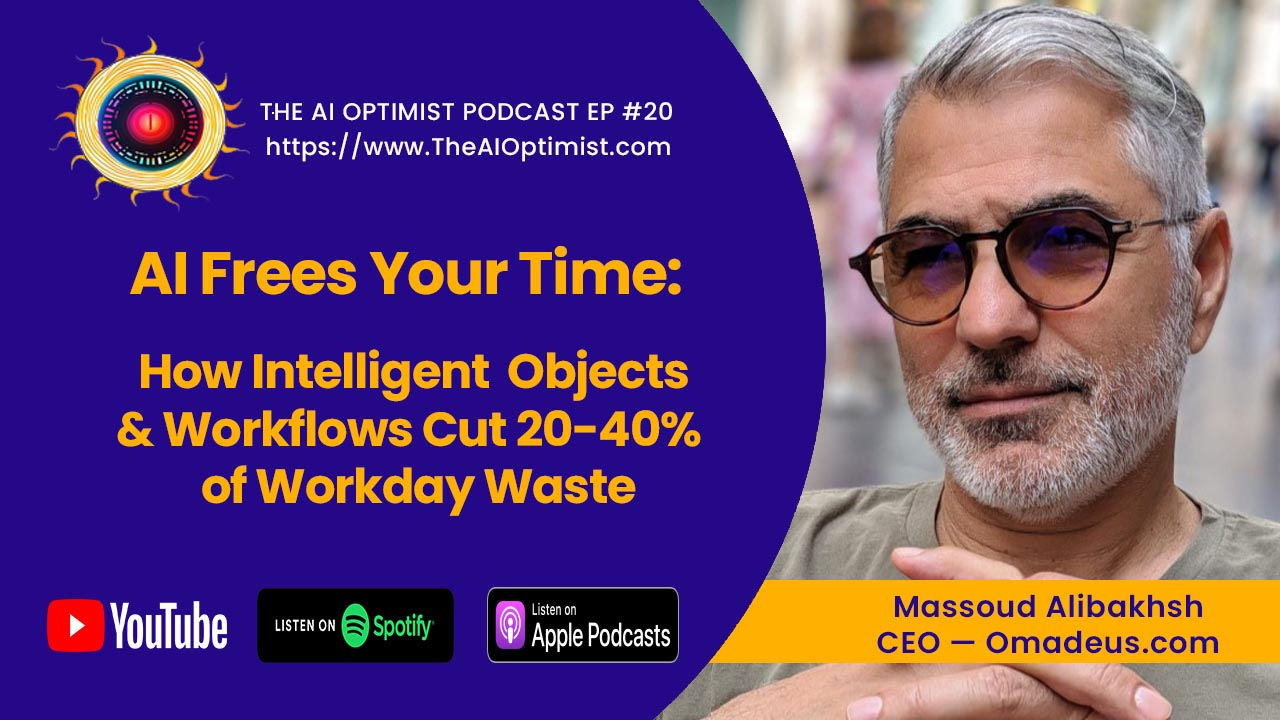What part of your business or job wears you down?
Often 20-40% of our working time is spent doing things like routing documents, updating people via email, and pushing files around to make sure the right people see them.
Now with the advance of AI, the first wave is often adding to this complex maze of administrative tasks, and it doesn’t have to…
Imagine the future of AI with Object Messaging and Intelligent Objects as a city. Each building (intelligent object) has its functions and responsibilities.
The roads connecting them (object messaging) ensure they communicate and work harmoniously.
Listen on Apple || Spotify || YouTube
Intro (0:00-2:30)
Massoud's Background – Why Omadeus? (2:30-5:00)
AI Replacing Jobs? (5:00-7:30)
The Invention - Intelligent Objects and Object Messaging (7:30-15:00)
Benefits of Intelligent Objects (15:00-22:00)
Comparing to LLMs (22:00-26:30)
Conclusion (26:30 to end)
Featured Guest
Massoud Alibakhsh, CEO of Omadeus
Theme: AI's role in workplace efficiency, focusing on intelligent objects and object messaging
As the CEO and founder of Omadeus, Massoud leads a visionary team in creating a new paradigm of AI-powered business software based on patents pending Object Messaging and Intelligent Objects (OMIO).
The product is an AI-powered project management, collaboration, documentation, and communication unified in one application for the entire company.
With over 20 years of experience as a tech entrepreneur and software architect, Massoud has launched, grown, and sold multiple software companies.
How Omadeus Uses AI
Omadeus is an AI agent integrating intelligent objects and object messaging into workflows. It streamlines processes by automating mundane tasks, facilitating better communication, and making systems more efficient.
With all the breakthroughs of AI, it's still adding complexity to business workflows. AI engineers treating AI as a tool instead of a platform may be continuing the tradition of information overload.
The actual value of AI is getting buried in dated work habits by depending on humans to route and manage information.
Instead, why don't we treat AI as a platform and automate the mundane and tedious parts of jobs?
Imagine having people do their job instead of acting as glorified administrators, frustrated and worn down by information management.
Podcast Highlights
AI's potential extends beyond just being a tool; it can act as a platform for redefining work processes.
Intelligent objects and object messaging can significantly reduce workday waste and increase efficiency.
The integration of AI in the workplace should be harmonious, augmenting human abilities rather than replacing them.
The AI Optimist Podcast Summary
Intro (0:00-2:30)
AI engineers treat AI as a hammer and everything else as nails. This approach needs to change.
Massoud Alibakhsh discusses how AI engineers often view AI as a universal solution suitable for various problems, including workplace challenges.
He sees AI as a tool that engineers want to apply everywhere. Still, it needs to be integrated thoughtfully into existing systems.
There's a need to integrate AI into automation frameworks harmoniously.
Massoud's Background – Why Omadeus? (2:30-5:00)
Built a system to connect multiple collaboration tools like Jira, Trello, Slack
Massoud describes Omadeus as a system that intelligently orchestrates information flow, comparing it to a symphony of harmonious interactions.
Omadeus.com uses AI to reduce workday inefficiencies and addresses the communication gap between people and systems.
AI Replacing Jobs? (5:00-7:30)
AI will automate mundane tasks, freeing humans to pursue their passions.
Massoud argues that intelligent objects help humans realize their potential by handling routine tasks.
AI provides opportunities for people instead of replacing them.
The Omadeus Invention (7:30-15:00)
Massoud introduces the concept of intelligent objects, with an x-ray example transforming into a smart object through AI integration.
Object messaging is the process where these intelligent objects communicate and navigate through workflows, interacting with humans and other objects.
He shares a detailed example of how an intelligent X-ray can navigate a healthcare system, making decisions and interacting with various stakeholders.
Current AI models process words; they don't understand meaning.
The real problem is integrating information across workflows and systems.
Proposes architecture inspired by biology for "intelligent objects."
Example: An X-ray is an intelligent object communicating relevant information to doctors.
Benefits of Intelligent Objects (15:00-22:00)
Objects become stakeholders, recording conversations and delivering information to the right people.
Much more automated and efficient than current manual workflows
Enables advanced workflows like auto coordination between multiple doctors
Comparing to LLMs (22:00-26:30)
LLMs have limitations around reliability and integration.
Intelligent objects complement LLMs by structuring information and workflows.
Massoud discusses the limits of current AI models, like ChatGPT, compared to the potential of Omadeus' approach.
He emphasizes the need for a new architecture that combines traditional programming with AI, particularly for mission-critical applications.
Conclusion (26:30-28:00)
We can build more automated, integrated, reliable systems with intelligent objects.
Combining traditional software with new AI architectures
Simple Definitions
Intelligent Objects: Entities in a digital environment that autonomously gather, process, and act upon data. They can make decisions and interact with other objects and humans in a workflow.
Object Messaging: The process of intelligent objects communicating and interacting within a digital ecosystem, sharing information, and making decisions to streamline workflows.
Action Plan:
Explore Integration of AI in Existing Systems: Investigate how AI enhances current workplace tools and processes.
Focus on Communication Improvement: Use AI to improve communication flow within organizations.
Embrace Intelligent Objects: Develop and implement intelligent objects to automate routine tasks, allowing human creativity to flourish.
Continuous Learning and Adaptation: Keep in touch with advancements in AI and adapt them to existing systems for continual progress.
Ethical and Responsible AI Use: Ensure AI is used responsibly and ethically, particularly in mission-critical applications.
Object Messaging and Intelligent Objects for AI
Object Messaging is not a new concept. Like people send and receive letters with messages, objects in computer systems send, receive, and process messages to execute functions.
Object-Oriented Programming (OOP) has used the idea of objects that send messages to one another to perform tasks.
Similarly, Intelligent Objects (also known as smart objects) are akin to tools with built-in intelligence. Imagine a hammer that adjusts its weight according to what it's striking.
These AI objects with embedded computing capabilities perform tasks without explicit instructions.
The convergence of Object Messaging and Intelligent Objects will change AI's path.
Here's why:
Pros:
Decentralized Processing: AI systems distribute tasks among intelligent objects, like a team splitting functions for efficiency.
Real-time Adaptation: Intelligent objects adjust in real-time, like a chameleon changing colors based on its surroundings.
Enhanced Integration: Object Messaging allows diverse AI systems to work harmoniously, like an orchestra playing in tune.
Cons:
Complexity: Managing communication between numerous objects is like coordinating a flash mob.
Security: With more objects communicating, there's a higher risk of security breaches, like having many doors in a house—more entry points for intruders.
Why They Matter
Object Messaging and Intelligent Objects have roots in older technologies but are becoming crucial for modern AI.
Fusing these concepts leads to adaptable and integrated AI systems, though complexity and security are concerns.
Companies like Omadeus and NVIDIA are pioneering this integration, a promising direction for AI's future.
How will the principles of Object Messaging influence the design of future AI algorithms?
Future AI algorithms will feel the impact of Object Messaging, making data intelligent and responsive instead of static:
1. Modular Design: Object Messaging is a system where components (objects) operate independently and communicate when necessary. AI designers will create modular algorithms, where each module handles a specific function, making AI systems more flexible and easier to update.
Consider a LEGO set. Each piece (module) has its function and can be combined in various ways (messages) to create different structures.
2. Improved Scalability: As tasks increase or become complex, new objects or modules are added to the system. The existing infrastructure can be a partial overhaul.
3. Real-time Adaptability: Objects in a messaging system receive and process data continuously. AI algorithms will adjust in real time based on incoming data.
4. Enhanced Collaboration: Object Messaging allows different AI systems or components to communicate seamlessly. They are encouraging the design of algorithms for collaboration, where multiple AI systems work together to solve a problem.
5. Increased Robustness: When one object fails in a system, others still function. If one part of an AI algorithm encounters an error, the system doesn't crash. The modular nature promoted by Object Messaging enhances system resilience.
6. Simplified Troubleshooting: With clear messaging protocols, when issues arise, they are traced back to specific objects or messages, simplifying the identification and repair of faults in AI algorithms.
Summary
Object Messaging promotes modular, scalable, and adaptable AI algorithm designs.
It encourages collaboration between AI systems and enhances system robustness.
Troubleshooting becomes straightforward with the clear paths provided by object messages.
How will combining Object Messaging and Intelligent Objects influence industries outside of tech, such as agriculture or healthcare?
Integrating Object Messaging and Intelligent Objects influences other sectors, like agriculture and healthcare.
Agriculture
1. Precision Farming: Intelligent Objects, like soil sensors, communicate (through Object Messaging) with irrigation systems to deliver precise amounts of water, optimizing crop yield. It's like conversing between the soil and the water system to determine the right amount of hydration.
2. Crop Health Monitoring: Drones equipped with AI sensors (Intelligent Objects) scan fields and send messages regarding areas with pest infestations or diseases. AI allows farmers to address problems selectively, reducing the blanket use of pesticides.
3. Automated Harvesting: Robotic harvesters decide when to pick fruits based on ripeness sensors and communicate to optimize storage conditions.
Healthcare
1. Patient Monitoring: Wearable devices (Intelligent Objects) continuously monitor patient vitals and, through Object Messaging, alert medical professionals or automated medication dispensers when needed.
2. Remote Diagnostics: Various diagnostic tools communicate to provide a holistic view of a patient's health. For instance, an MRI machine might "discuss" results with a blood test machine to give doctors a clearer picture.
3. Intelligent Prosthetics: Prosthetic devices adapt in real time based on the user's activity level and send feedback to healthcare providers for adjustments.
4. Drug Delivery Systems: Medication dispensers are programmed to release drugs based on the data received from other devices. If a heart rate monitor detects arrhythmia, it messages an implantable drug delivery device to release a specific dose of medication.
Imagine a well-coordinated orchestra. Each instrument (Intelligent Object) plays its part in agriculture, and the conductor (Object Messaging) ensures harmony.
Each medical device is a musician in healthcare, and the patient's well-being is the symphony.
Influences of AI
By integrating these concepts, agriculture witnesses improved precision, better crop health monitoring, and efficient harvesting.
Healthcare sees enhanced patient monitoring, diagnostics, prosthetics, and drug delivery systems.
Both industries achieve higher efficiency and accuracy with reduced human intervention.
What are the challenges in implementing Object Messaging in real-world AI applications?
1. Integration with Legacy Systems: Integrating Object Messaging with older systems not designed for it could lead to compatibility issues.
2. Increased Complexity: Managing communication between numerous objects adds layers of complexity.
3. Latency Issues: Real-time communication between objects faces delays, especially with vast data transfer.
4. Security Concerns: More communication points mean more points of vulnerability.
5. Synchronization Challenges: Ensuring all objects operate harmoniously without overlapping or conflicting is challenging.
6. Maintenance: As objects increase in number and complexity, maintaining them becomes problematic.
Benefits of Object Messaging in Real-Time Data-Reliant Industries
Finance
1. Real-time Decision Making: Trading algorithms communicate instantly with data analysis tools to make split-second buying or selling decisions based on market fluctuations.
2. Enhanced Security: Financial transactions are more secure when security tools communicate in real-time to identify and combat threats.
3. Personalized Banking: Banking systems use Object Messaging to tailor services based on real-time customer data, like a bank teller knowing your needs when you walk in.
Autonomous Vehicles
1. Real-time Adaptation: Cars communicate with traffic lights, road sensors, and other vehicles to adjust routes, speed, or driving strategy in real time.
2. Enhanced Safety: If one vehicle detects a hazard, it immediately informs nearby cars, acting as a quick-reacting network.
3. Traffic Flow Optimization: Vehicles communicate to optimize traffic flow, reducing congestion and ensuring smoother rides.
Think of Object Messaging as the nervous system in a body. Finance allows the brain (algorithms) to react quickly to stimuli (market changes).
In autonomous vehicles, it lets the car "feel" its environment and adjust accordingly.
Key Insights
Implementing Object Messaging in AI is challenging due to integration, complexity, latency, security, synchronization, and maintenance concerns.
Industries like finance and autonomous vehicles benefit from real-time decision-making, enhanced security, personalized services, and improved safety and adaptability.
What are possible unforeseen consequences of relying heavily on Intelligent Objects in critical sectors like healthcare, and how might they be eased?
1. Over-reliance on Automation: Healthcare professionals might become too dependent on Intelligent Objects, potentially reducing diagnostic or treatment skills.
It's like someone relying solely on GPS and losing their innate sense of direction.
2. Malfunctions or Failures: Any technical glitch or malfunction in an Intelligent Object leads to misdiagnoses, incorrect medication dosages, or surgical mishaps.
3. Data Privacy Concerns: The continuous collection and communication of patient data raises concerns about privacy and potential misuse.
4. Loss of Personal Touch: With increased automation, patients might feel the healthcare experience could be more impersonal, missing the human touch.
5. Potential for Hacking: With data exchanges between Intelligent Objects, there's an increased risk of cyber-attacks, potentially exposing patient health and information.
6. Ethical Concerns: Decisions made by Intelligent Objects might not always align with ethical considerations, especially in life-and-death situations.
How to Avoid Challenges
1. Continuous Training: Healthcare professionals receive ongoing training to ensure they maintain their skills and aren't solely reliant on technology.
2. Redundancy Systems: Having backup systems in place prevents complete failures. If one Intelligent Object malfunctions, another takes over.
3. Robust Data Protection: Employing strong encryption methods and stringent data protection protocols to safeguard patient data.
4. Human-AI Collaboration: Ensuring that decisions, especially critical ones, are made with both human and AI input balances automation with the personal touch.
5. Advanced Security Protocols: Regular system updates, intrusion detection systems, and advanced firewalls help guard against cyber-attacks.
6. Ethical Guidelines: Establishing ethical guidelines for developing and deploying Intelligent Objects ensures that they align with human values.
Summary
While Intelligent Objects will help healthcare, there are potential pitfalls, including over-reliance, malfunctions, data privacy issues, loss of personal touch, security threats, and ethical dilemmas.
Mitigation strategies address these concerns, such as continuous training, redundancy, robust data protection, human-AI collaboration, advanced security measures, and ethical guidelines.



















